Advanced Functions - Equation of Mathews’ gastronomic tract
VerifiedAdded on 2022/08/23
|12
|1213
|29
AI Summary
Contribute Materials
Your contribution can guide someone’s learning journey. Share your
documents today.
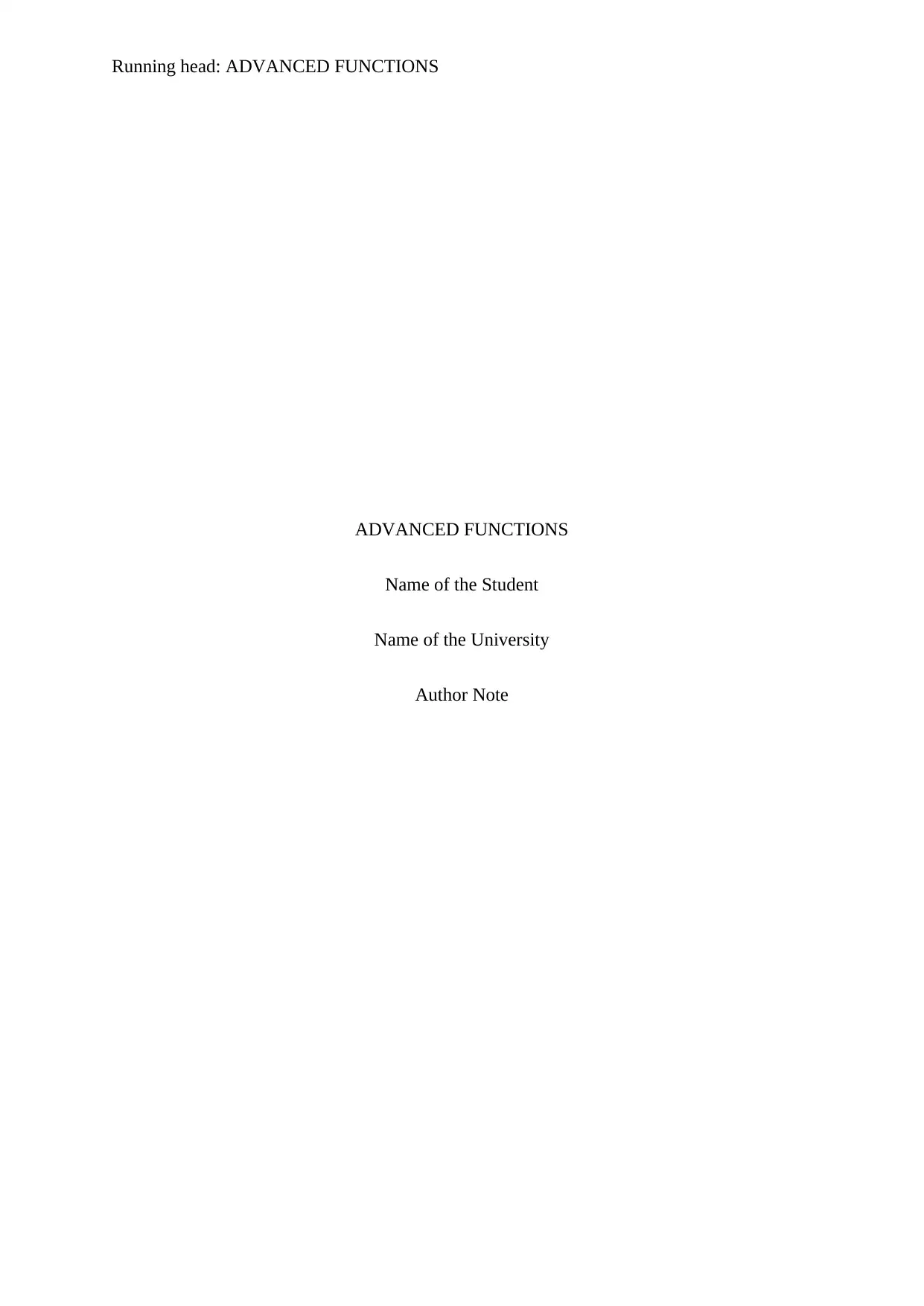
Running head: ADVANCED FUNCTIONS
ADVANCED FUNCTIONS
Name of the Student
Name of the University
Author Note
ADVANCED FUNCTIONS
Name of the Student
Name of the University
Author Note
Secure Best Marks with AI Grader
Need help grading? Try our AI Grader for instant feedback on your assignments.
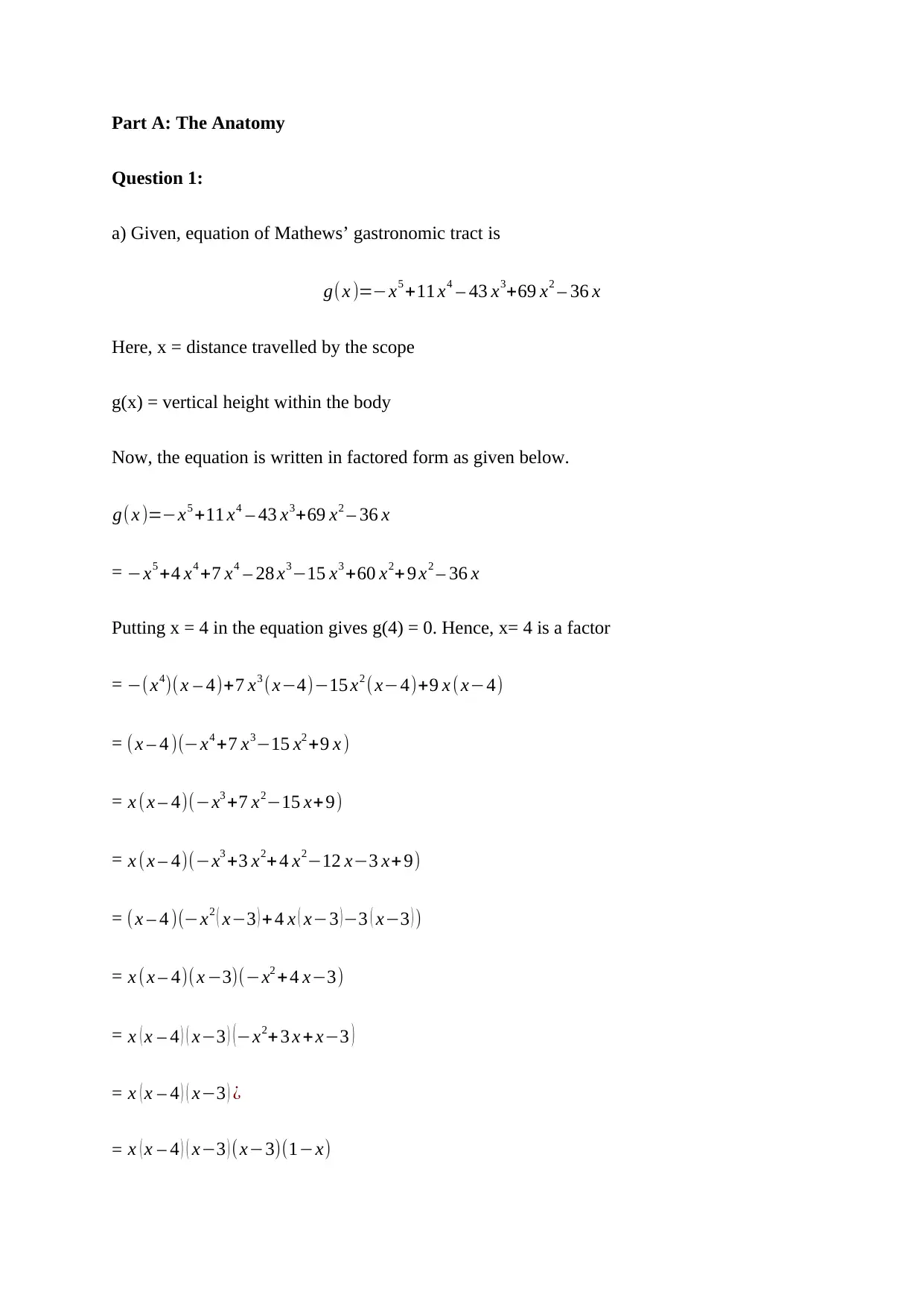
Part A: The Anatomy
Question 1:
a) Given, equation of Mathews’ gastronomic tract is
g(x )=−x5 +11 x4 – 43 x3+69 x2 – 36 x
Here, x = distance travelled by the scope
g(x) = vertical height within the body
Now, the equation is written in factored form as given below.
g( x )=−x5 +11 x4 – 43 x3+69 x2 – 36 x
= −x5 +4 x4 +7 x4 – 28 x3−15 x3 +60 x2+ 9 x2 – 36 x
Putting x = 4 in the equation gives g(4) = 0. Hence, x= 4 is a factor
= −(x4)(x – 4)+7 x3 (x−4)−15 x2 ( x−4)+9 x ( x−4)
= ( x – 4 )(−x4 +7 x3−15 x2 +9 x )
= x ( x – 4)(−x3 +7 x2−15 x+9)
= x ( x – 4)(−x3 +3 x2+ 4 x2−12 x−3 x+9)
= ( x – 4 )(−x2 ( x−3 ) + 4 x ( x−3 )−3 ( x−3 ) )
= x ( x – 4)( x −3)(−x2 +4 x−3)
= x ( x – 4 ) ( x−3 ) (−x2+ 3 x +x−3 )
= x ( x – 4 ) ( x−3 ) ¿
= x ( x – 4 ) ( x−3 ) (x−3)(1−x)
Question 1:
a) Given, equation of Mathews’ gastronomic tract is
g(x )=−x5 +11 x4 – 43 x3+69 x2 – 36 x
Here, x = distance travelled by the scope
g(x) = vertical height within the body
Now, the equation is written in factored form as given below.
g( x )=−x5 +11 x4 – 43 x3+69 x2 – 36 x
= −x5 +4 x4 +7 x4 – 28 x3−15 x3 +60 x2+ 9 x2 – 36 x
Putting x = 4 in the equation gives g(4) = 0. Hence, x= 4 is a factor
= −(x4)(x – 4)+7 x3 (x−4)−15 x2 ( x−4)+9 x ( x−4)
= ( x – 4 )(−x4 +7 x3−15 x2 +9 x )
= x ( x – 4)(−x3 +7 x2−15 x+9)
= x ( x – 4)(−x3 +3 x2+ 4 x2−12 x−3 x+9)
= ( x – 4 )(−x2 ( x−3 ) + 4 x ( x−3 )−3 ( x−3 ) )
= x ( x – 4)( x −3)(−x2 +4 x−3)
= x ( x – 4 ) ( x−3 ) (−x2+ 3 x +x−3 )
= x ( x – 4 ) ( x−3 ) ¿
= x ( x – 4 ) ( x−3 ) (x−3)(1−x)
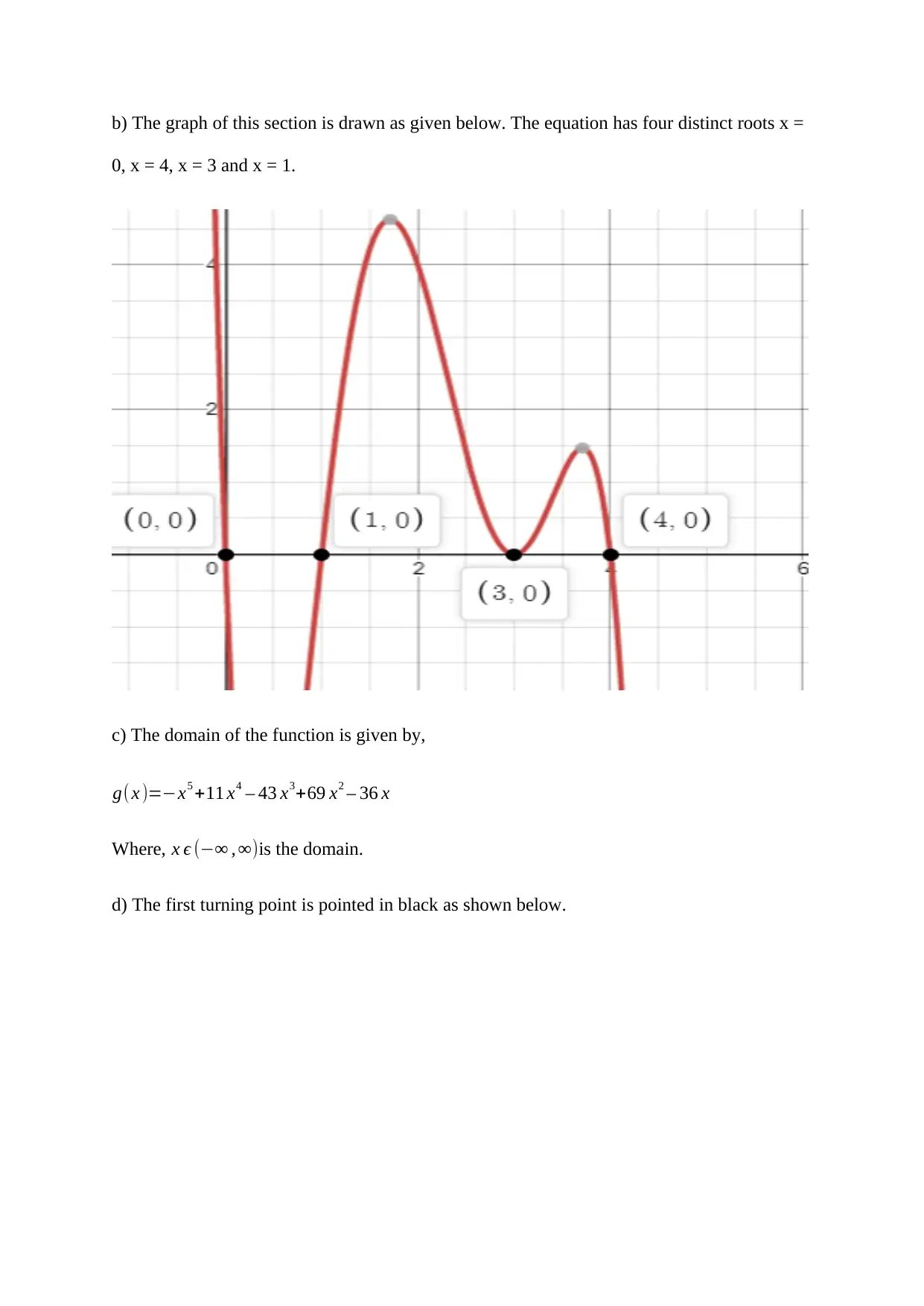
b) The graph of this section is drawn as given below. The equation has four distinct roots x =
0, x = 4, x = 3 and x = 1.
c) The domain of the function is given by,
g( x )=−x5 +11 x4 – 43 x3+69 x2 – 36 x
Where, x ϵ (−∞ , ∞)is the domain.
d) The first turning point is pointed in black as shown below.
0, x = 4, x = 3 and x = 1.
c) The domain of the function is given by,
g( x )=−x5 +11 x4 – 43 x3+69 x2 – 36 x
Where, x ϵ (−∞ , ∞)is the domain.
d) The first turning point is pointed in black as shown below.
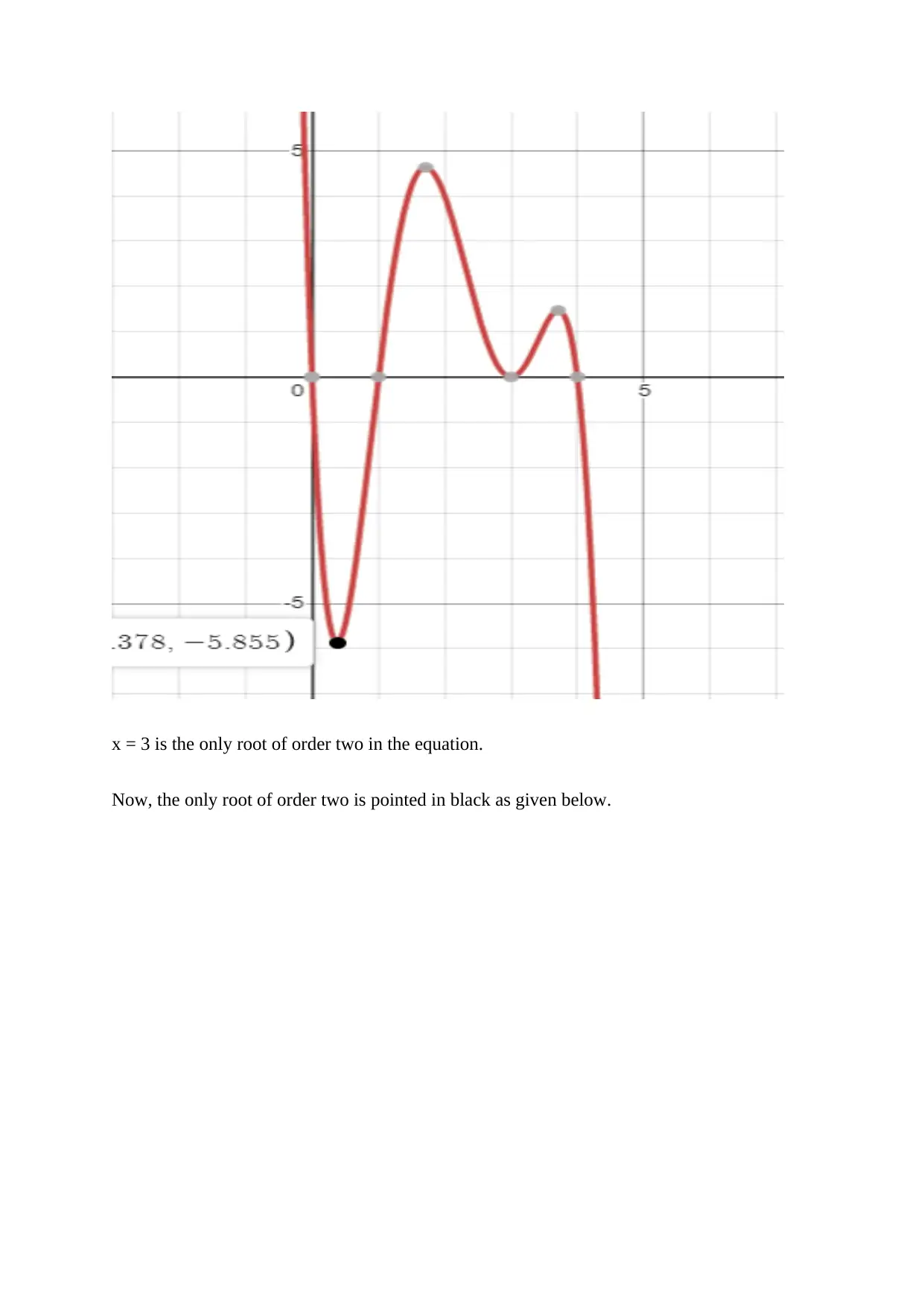
x = 3 is the only root of order two in the equation.
Now, the only root of order two is pointed in black as given below.
Now, the only root of order two is pointed in black as given below.
Secure Best Marks with AI Grader
Need help grading? Try our AI Grader for instant feedback on your assignments.
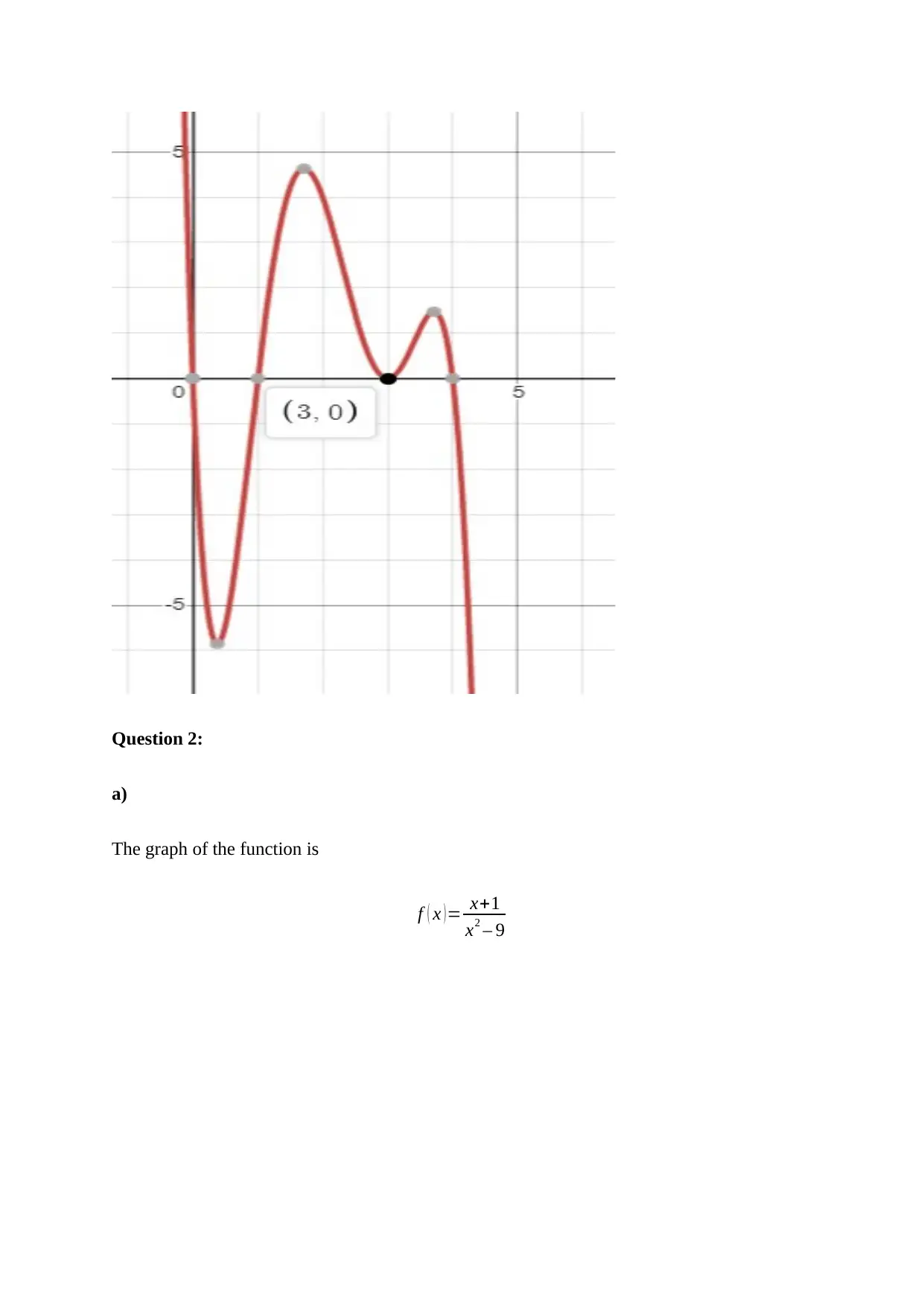
Question 2:
a)
The graph of the function is
f ( x ) = x+1
x2 – 9
a)
The graph of the function is
f ( x ) = x+1
x2 – 9
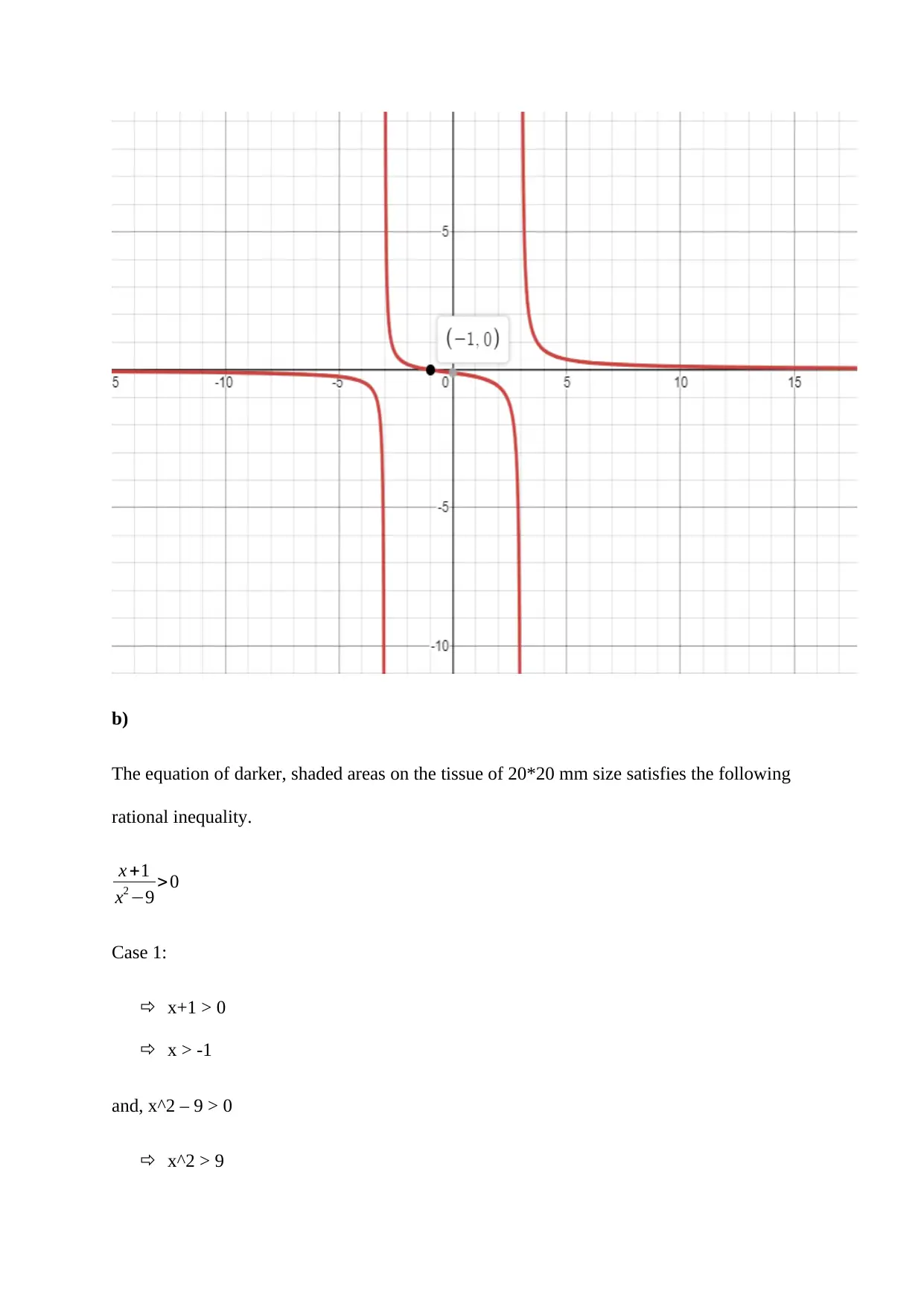
b)
The equation of darker, shaded areas on the tissue of 20*20 mm size satisfies the following
rational inequality.
x +1
x2 −9 >0
Case 1:
x+1 > 0
x > -1
and, x^2 – 9 > 0
x^2 > 9
The equation of darker, shaded areas on the tissue of 20*20 mm size satisfies the following
rational inequality.
x +1
x2 −9 >0
Case 1:
x+1 > 0
x > -1
and, x^2 – 9 > 0
x^2 > 9
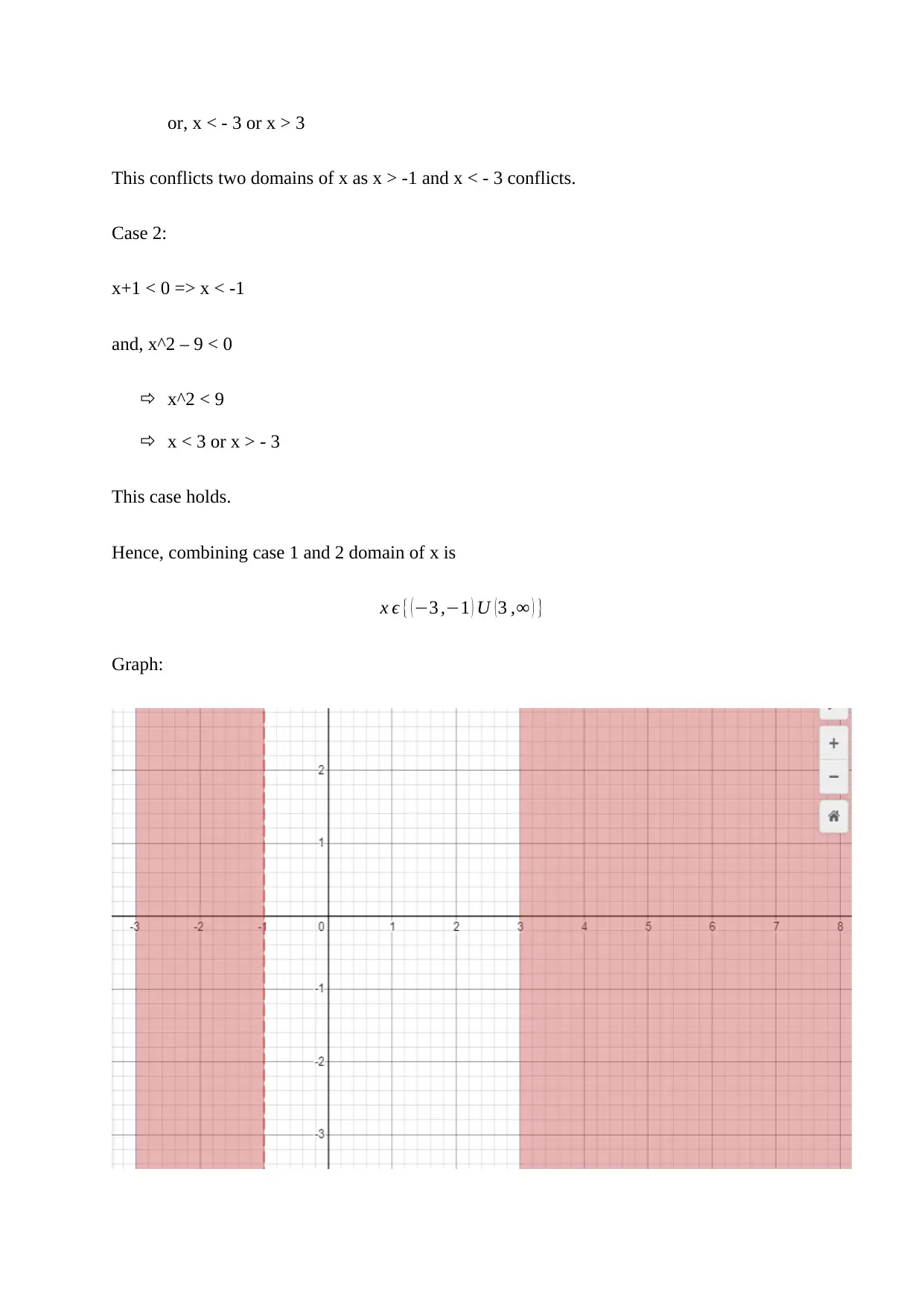
or, x < - 3 or x > 3
This conflicts two domains of x as x > -1 and x < - 3 conflicts.
Case 2:
x+1 < 0 => x < -1
and, x^2 – 9 < 0
x^2 < 9
x < 3 or x > - 3
This case holds.
Hence, combining case 1 and 2 domain of x is
x ϵ { (−3 ,−1 ) U (3 ,∞ ) }
Graph:
This conflicts two domains of x as x > -1 and x < - 3 conflicts.
Case 2:
x+1 < 0 => x < -1
and, x^2 – 9 < 0
x^2 < 9
x < 3 or x > - 3
This case holds.
Hence, combining case 1 and 2 domain of x is
x ϵ { (−3 ,−1 ) U (3 ,∞ ) }
Graph:
Paraphrase This Document
Need a fresh take? Get an instant paraphrase of this document with our AI Paraphraser
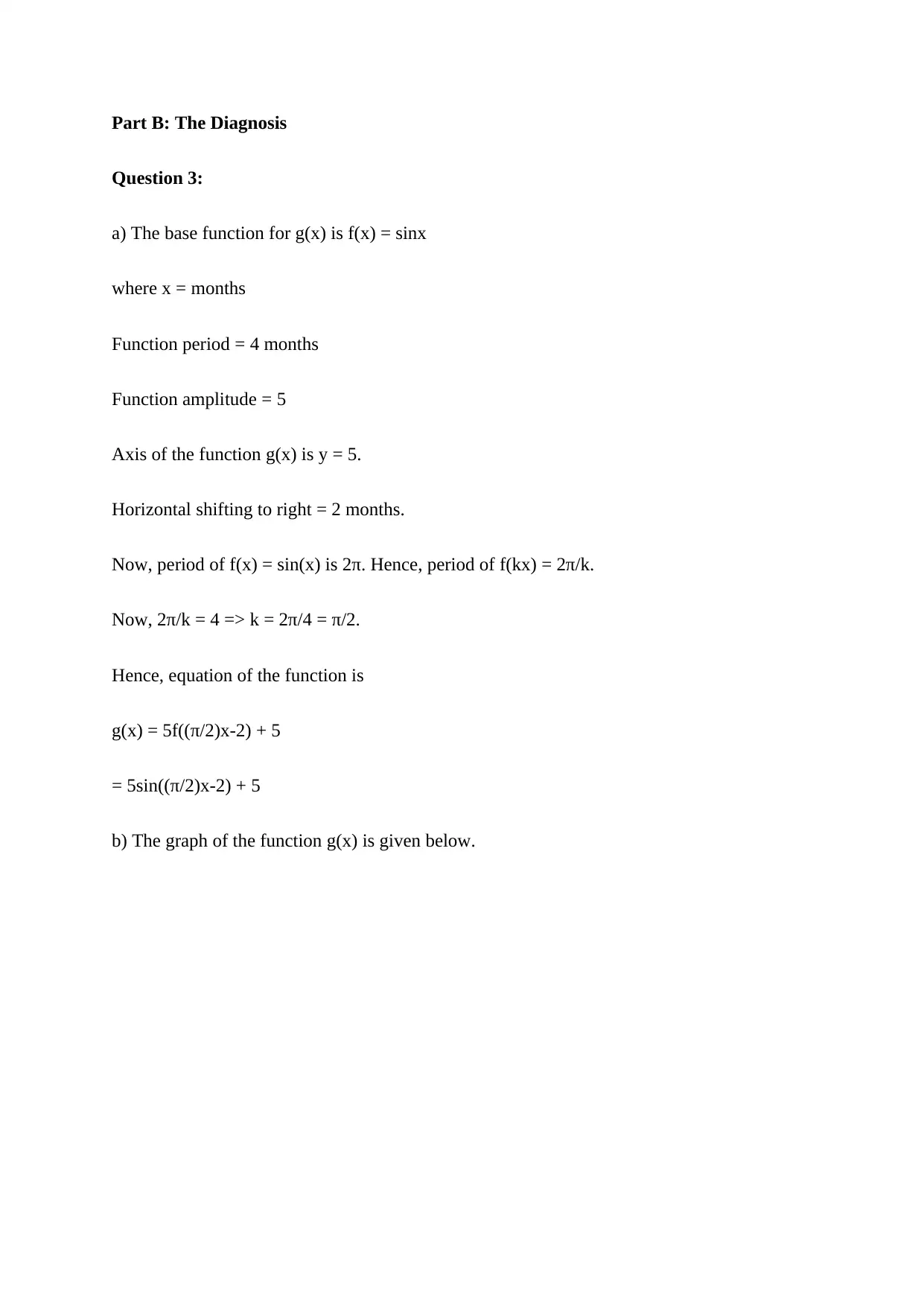
Part B: The Diagnosis
Question 3:
a) The base function for g(x) is f(x) = sinx
where x = months
Function period = 4 months
Function amplitude = 5
Axis of the function g(x) is y = 5.
Horizontal shifting to right = 2 months.
Now, period of f(x) = sin(x) is 2π. Hence, period of f(kx) = 2π/k.
Now, 2π/k = 4 => k = 2π/4 = π/2.
Hence, equation of the function is
g(x) = 5f((π/2)x-2) + 5
= 5sin((π/2)x-2) + 5
b) The graph of the function g(x) is given below.
Question 3:
a) The base function for g(x) is f(x) = sinx
where x = months
Function period = 4 months
Function amplitude = 5
Axis of the function g(x) is y = 5.
Horizontal shifting to right = 2 months.
Now, period of f(x) = sin(x) is 2π. Hence, period of f(kx) = 2π/k.
Now, 2π/k = 4 => k = 2π/4 = π/2.
Hence, equation of the function is
g(x) = 5f((π/2)x-2) + 5
= 5sin((π/2)x-2) + 5
b) The graph of the function g(x) is given below.
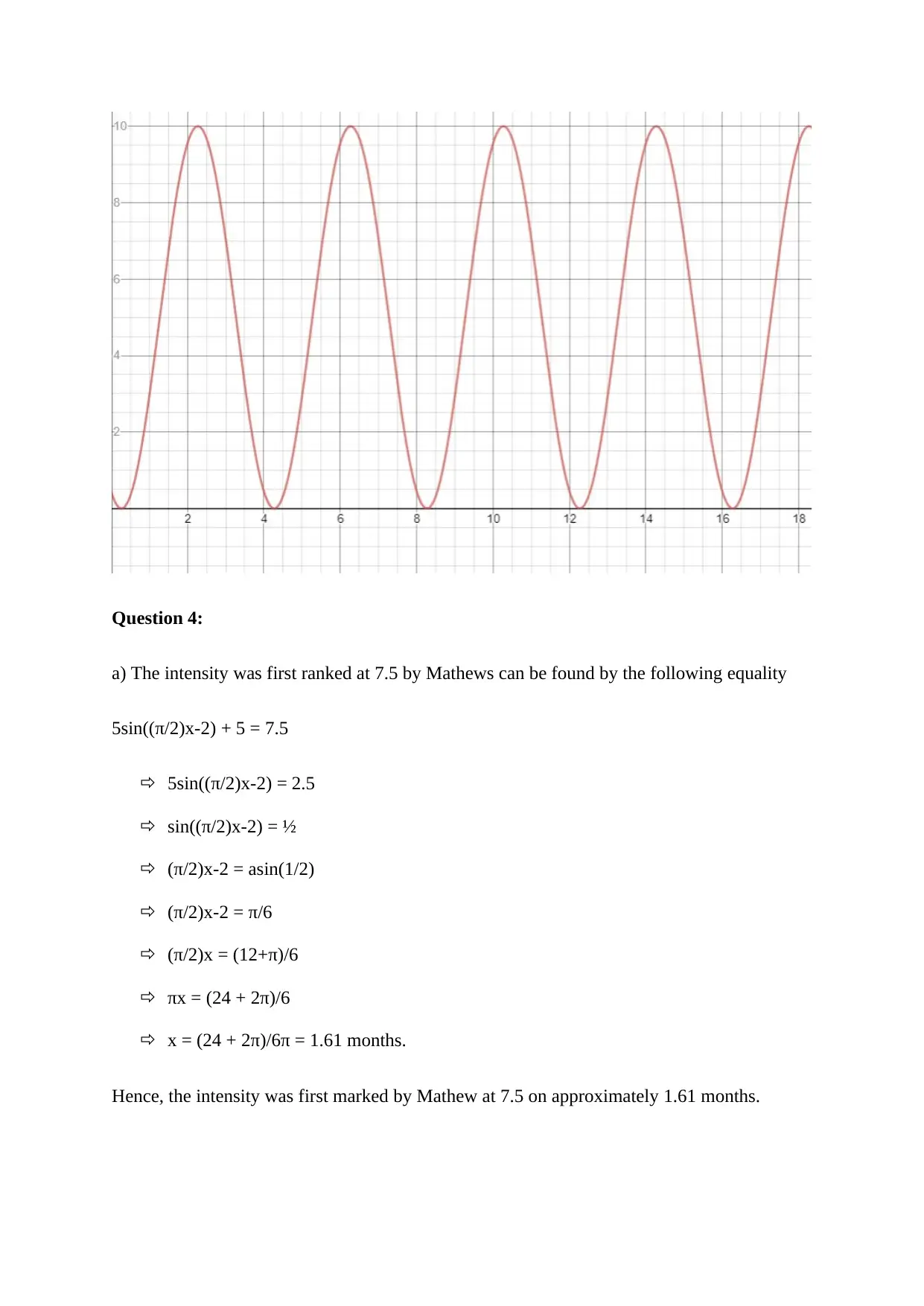
Question 4:
a) The intensity was first ranked at 7.5 by Mathews can be found by the following equality
5sin((π/2)x-2) + 5 = 7.5
5sin((π/2)x-2) = 2.5
sin((π/2)x-2) = ½
(π/2)x-2 = asin(1/2)
(π/2)x-2 = π/6
(π/2)x = (12+π)/6
πx = (24 + 2π)/6
x = (24 + 2π)/6π = 1.61 months.
Hence, the intensity was first marked by Mathew at 7.5 on approximately 1.61 months.
a) The intensity was first ranked at 7.5 by Mathews can be found by the following equality
5sin((π/2)x-2) + 5 = 7.5
5sin((π/2)x-2) = 2.5
sin((π/2)x-2) = ½
(π/2)x-2 = asin(1/2)
(π/2)x-2 = π/6
(π/2)x = (12+π)/6
πx = (24 + 2π)/6
x = (24 + 2π)/6π = 1.61 months.
Hence, the intensity was first marked by Mathew at 7.5 on approximately 1.61 months.
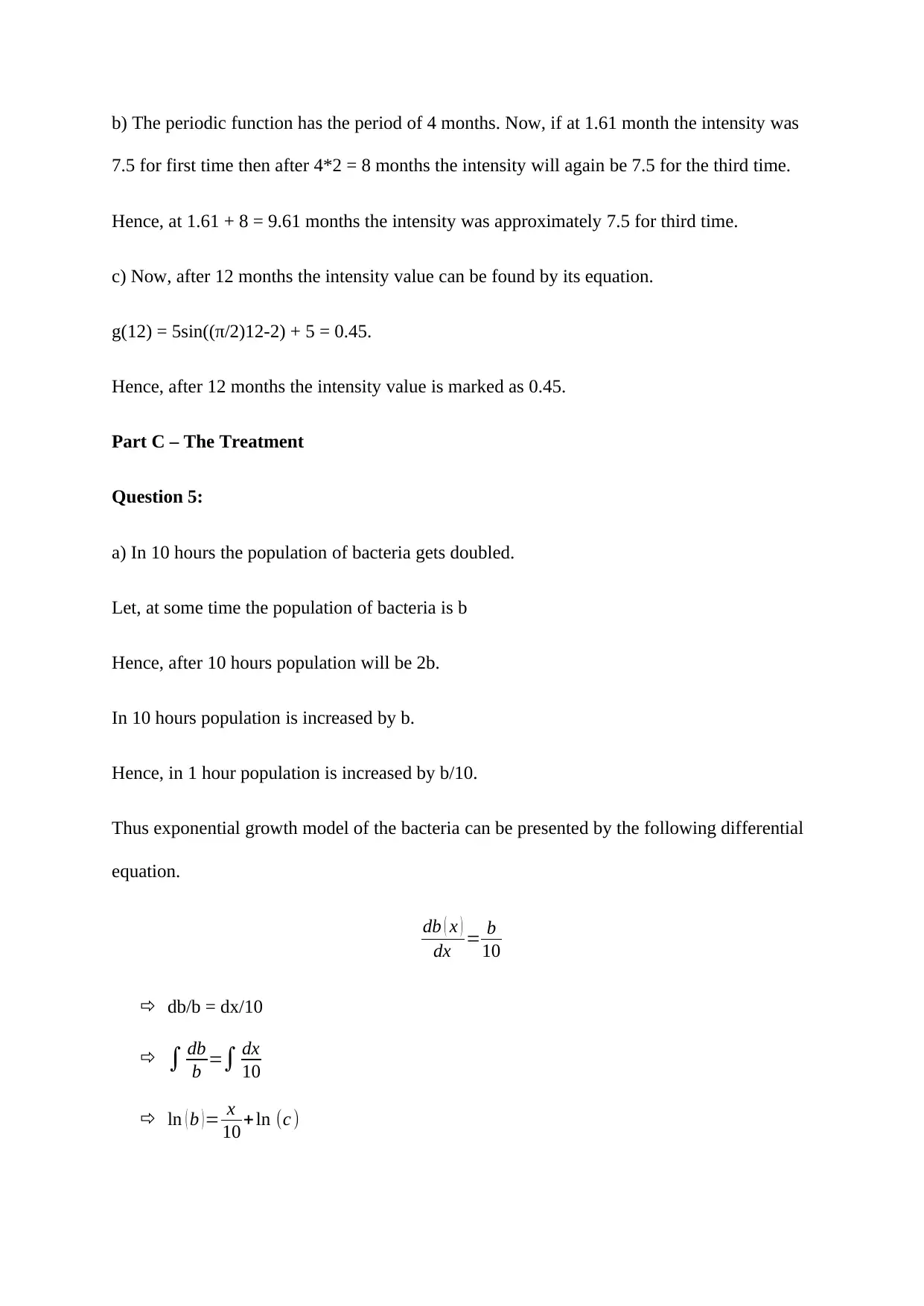
b) The periodic function has the period of 4 months. Now, if at 1.61 month the intensity was
7.5 for first time then after 4*2 = 8 months the intensity will again be 7.5 for the third time.
Hence, at 1.61 + 8 = 9.61 months the intensity was approximately 7.5 for third time.
c) Now, after 12 months the intensity value can be found by its equation.
g(12) = 5sin((π/2)12-2) + 5 = 0.45.
Hence, after 12 months the intensity value is marked as 0.45.
Part C – The Treatment
Question 5:
a) In 10 hours the population of bacteria gets doubled.
Let, at some time the population of bacteria is b
Hence, after 10 hours population will be 2b.
In 10 hours population is increased by b.
Hence, in 1 hour population is increased by b/10.
Thus exponential growth model of the bacteria can be presented by the following differential
equation.
db ( x )
dx = b
10
db/b = dx/10
∫ db
b =∫ dx
10
ln ( b ) = x
10 + ln (c )
7.5 for first time then after 4*2 = 8 months the intensity will again be 7.5 for the third time.
Hence, at 1.61 + 8 = 9.61 months the intensity was approximately 7.5 for third time.
c) Now, after 12 months the intensity value can be found by its equation.
g(12) = 5sin((π/2)12-2) + 5 = 0.45.
Hence, after 12 months the intensity value is marked as 0.45.
Part C – The Treatment
Question 5:
a) In 10 hours the population of bacteria gets doubled.
Let, at some time the population of bacteria is b
Hence, after 10 hours population will be 2b.
In 10 hours population is increased by b.
Hence, in 1 hour population is increased by b/10.
Thus exponential growth model of the bacteria can be presented by the following differential
equation.
db ( x )
dx = b
10
db/b = dx/10
∫ db
b =∫ dx
10
ln ( b ) = x
10 + ln (c )
Secure Best Marks with AI Grader
Need help grading? Try our AI Grader for instant feedback on your assignments.
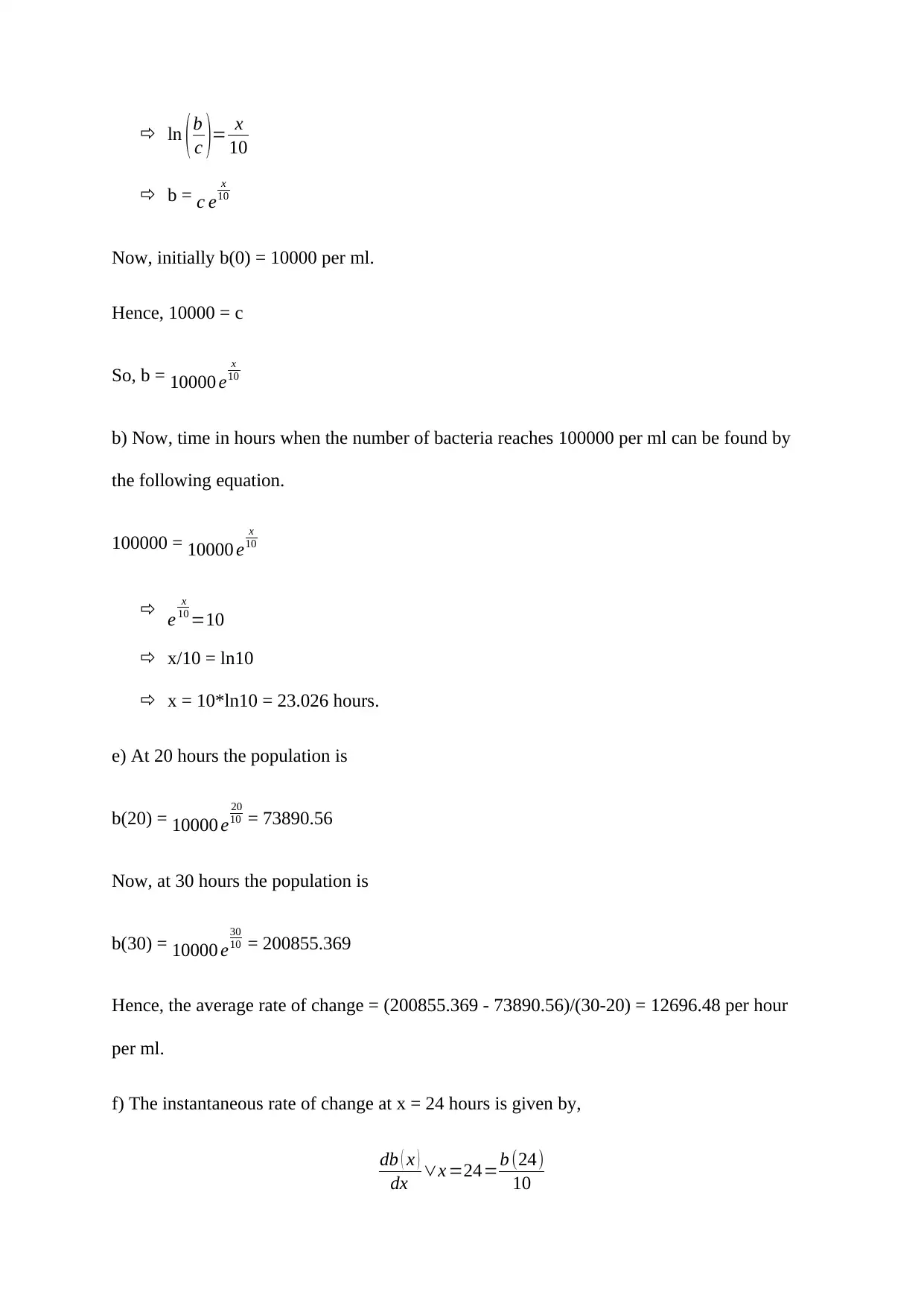
ln (b
c )= x
10
b = c e
x
10
Now, initially b(0) = 10000 per ml.
Hence, 10000 = c
So, b = 10000 e
x
10
b) Now, time in hours when the number of bacteria reaches 100000 per ml can be found by
the following equation.
100000 = 10000 e
x
10
e
x
10 =10
x/10 = ln10
x = 10*ln10 = 23.026 hours.
e) At 20 hours the population is
b(20) = 10000 e
20
10 = 73890.56
Now, at 30 hours the population is
b(30) = 10000 e
30
10 = 200855.369
Hence, the average rate of change = (200855.369 - 73890.56)/(30-20) = 12696.48 per hour
per ml.
f) The instantaneous rate of change at x = 24 hours is given by,
db ( x )
dx ∨x =24=b (24)
10
c )= x
10
b = c e
x
10
Now, initially b(0) = 10000 per ml.
Hence, 10000 = c
So, b = 10000 e
x
10
b) Now, time in hours when the number of bacteria reaches 100000 per ml can be found by
the following equation.
100000 = 10000 e
x
10
e
x
10 =10
x/10 = ln10
x = 10*ln10 = 23.026 hours.
e) At 20 hours the population is
b(20) = 10000 e
20
10 = 73890.56
Now, at 30 hours the population is
b(30) = 10000 e
30
10 = 200855.369
Hence, the average rate of change = (200855.369 - 73890.56)/(30-20) = 12696.48 per hour
per ml.
f) The instantaneous rate of change at x = 24 hours is given by,
db ( x )
dx ∨x =24=b (24)
10
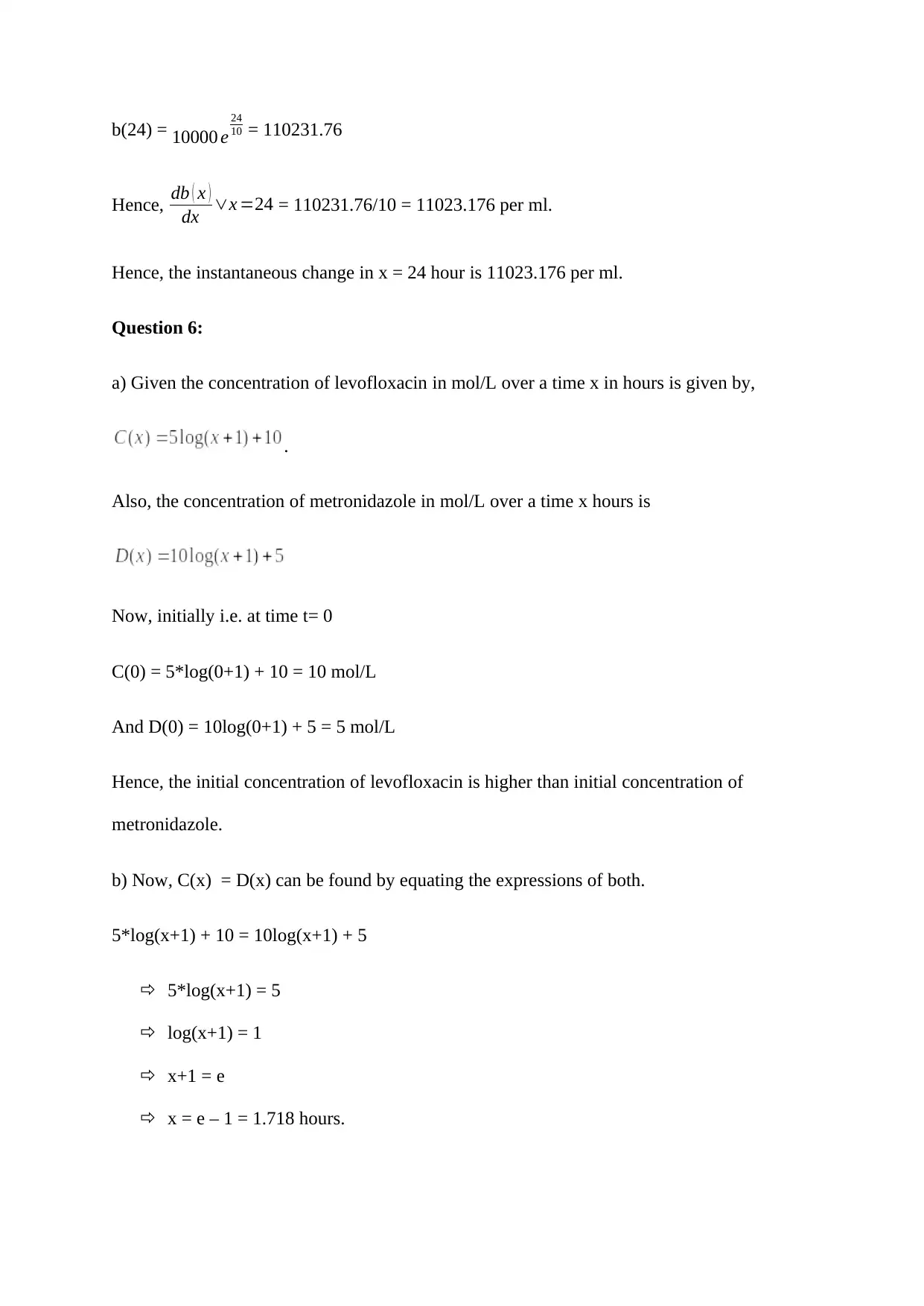
b(24) = 10000 e
24
10 = 110231.76
Hence, db ( x )
dx ∨x =24 = 110231.76/10 = 11023.176 per ml.
Hence, the instantaneous change in x = 24 hour is 11023.176 per ml.
Question 6:
a) Given the concentration of levofloxacin in mol/L over a time x in hours is given by,
.
Also, the concentration of metronidazole in mol/L over a time x hours is
Now, initially i.e. at time t= 0
C(0) = 5*log(0+1) + 10 = 10 mol/L
And D(0) = 10log(0+1) + 5 = 5 mol/L
Hence, the initial concentration of levofloxacin is higher than initial concentration of
metronidazole.
b) Now, C(x) = D(x) can be found by equating the expressions of both.
5*log(x+1) + 10 = 10log(x+1) + 5
5*log(x+1) = 5
log(x+1) = 1
x+1 = e
x = e – 1 = 1.718 hours.
24
10 = 110231.76
Hence, db ( x )
dx ∨x =24 = 110231.76/10 = 11023.176 per ml.
Hence, the instantaneous change in x = 24 hour is 11023.176 per ml.
Question 6:
a) Given the concentration of levofloxacin in mol/L over a time x in hours is given by,
.
Also, the concentration of metronidazole in mol/L over a time x hours is
Now, initially i.e. at time t= 0
C(0) = 5*log(0+1) + 10 = 10 mol/L
And D(0) = 10log(0+1) + 5 = 5 mol/L
Hence, the initial concentration of levofloxacin is higher than initial concentration of
metronidazole.
b) Now, C(x) = D(x) can be found by equating the expressions of both.
5*log(x+1) + 10 = 10log(x+1) + 5
5*log(x+1) = 5
log(x+1) = 1
x+1 = e
x = e – 1 = 1.718 hours.
1 out of 12
Related Documents
Your All-in-One AI-Powered Toolkit for Academic Success.
+13062052269
info@desklib.com
Available 24*7 on WhatsApp / Email
![[object Object]](/_next/static/media/star-bottom.7253800d.svg)
Unlock your academic potential
© 2024 | Zucol Services PVT LTD | All rights reserved.




